Home
> Scales
> Solo
Over Extended Chords
In some cases however, especially in jazz, the chord's tones will be stacked beyond the 7th to a 9th, 11th or 13th. If this sounds completely foreign to you, I recommend first taking the extended chord theory lesson for an intro to extended chords.
Remember, effective soloing is about more than simply choosing the right scale. So although what we're learning here is a crucial first step, you still need to learn how to use scales fluidly and musically in your solos once you've chosen your scale/notes.
I know what you may be thinking - how does the number 2 correspond to the number 9 in 9th chords? Well, in music theory, the 9 is technically the same as 2, 11 the same as 4 and 13 the same as 6. If you see a chord written with a 13, you should know you're looking for a scale which includes a 6th. This is why I always label my scale diagrams with their intervals.
I know it might be confusing but there is a good reason for this distinction - mainly because when the chord extends beyond the 7th, you need higher numbers to represent that.
Why have I placed the 4 in brackets for 13th and major 13th chords? Because on guitar, the 4th/11th is rarely included in these chords, for more economical fingering (after all, there are only 6 strings on the guitar and a full 13th chord with the 11th would require 7 notes to be played). The 11th is only theoretically part of the stack of tones.
Ok, before we get too bogged down in the theory, let's take a look at some practical examples.
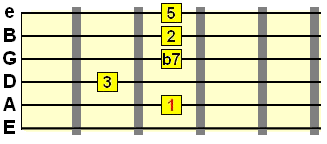
We can see that the tones that make up the chord are the root (1), major 3rd (3), 5th (5), minor 7th (b7) and 9th (2).
So whichever scale we choose to solo over that chord, should also include those tones (with the exception of major pentatonic which contains no 7th, but works because it is effectively "7th neutral").
Mixolydian includes all these tones...
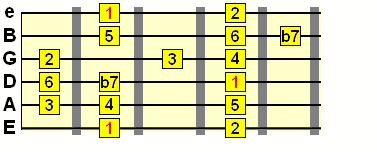
As does Lydian dominant...
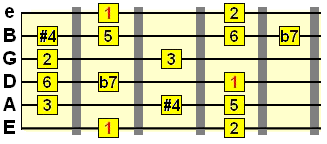
But Phrygian dominant, which we learned works naturally over dominant 7th chords, uses a minor 2nd (b2) which would clash with the major 2nd of the extended 9th chord...
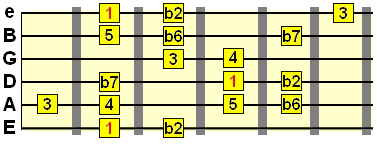
The exact same scales could be used for dominant 13th chords (e.g. C13), because both Mixolydian and Lydian dominant also include the 13th (6), but Phrygian dominant uses a minor 6th (b6), so again, wouldn't be compatible.
Eventually, you won't think of it as "X scale = compatible, Y scale = incompatible", rather which tones are compatible/incompatibe. Scales are just a convenient way to group harmonically related tones together. It's the individual tones that define harmony or dissonance over a chord.
See if you can find compatible scales/tones for major 9th and major 13th chords. Use the table from earlier to help you identify the right tones.
With minor 9th chords (e.g. Cm9), it's exactly the same process, but this time we're looking for minor scales that include the root (1), minor 3rd (b3), 5th (5), flat 7th (b7) and 9th (2).
A typical minor 9th barre chord shape...
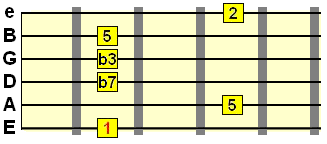
Both natural minor and Dorian would work, since they both include these tones...
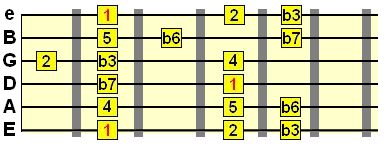
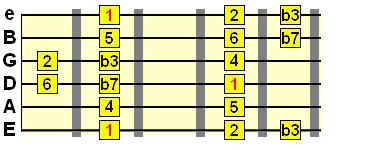
But notice how natural minor wouldn't be compatible with a minor 13th chord (e.g. Cm13), because it uses a flat 6th (b6) rather than a major 6th (6).
Again, try and think more in terms of individual tones being compatible/incompatible, rather than entire scales. I've just presented it this way because it's a good starting point.
There is also (less of) a dissonance between the 11th and dominant 7th chord intervals, so what you'll find is 11th chords are simply used as extensions of suspended 4th chords, consisting of the root (1), 4th (4), 5th (5), flat 7th (b7) and 9th (2).
Here's a typical voicing for an 11th chord (e.g. C11)...
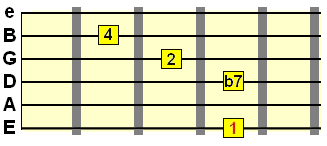
(note that the 5th is left out for more economical fingering on guitar - that's fine).
Mixolydian would work well over 11th chords...

Minor 11th chords (e.g. Cm11) include the root (1), minor 3rd (b3), 5th (5), flat 7th (b7) and 11th (4).
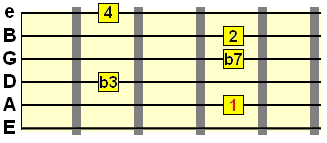
(Again, I've left out the 5th to make the fingering easier - as the 5th is a relatively neutral tone, the chord doesn't lose its "flavour" if you omit it).
Both Dorian and natural minor would work...


So, hopefully you're starting to get more confident with connecting the right scales/tones to extended chord types and chords in general.
But do be aware of sharp or flat tones in the chords you solo over, as this will determine which scale tones should be flat or sharp. It's exactly the same process we've been following, but some chords will include tones that typical 7 note scales won't cater for.
That's why you should learn to hear and visualise how individual tones correspond to the chords you're playing over, because it'll make it easier to to sharpen or flatten a given tone if the chord harmony requires it.
For example, take this commonly used (at least in jazz!) altered chord (e.g. C7#9#5)...
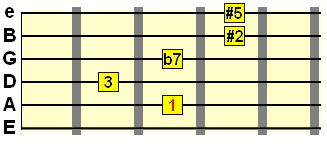
The scale most players would use is the altered scale, because it accomodates those sharps (#2 and #5)...
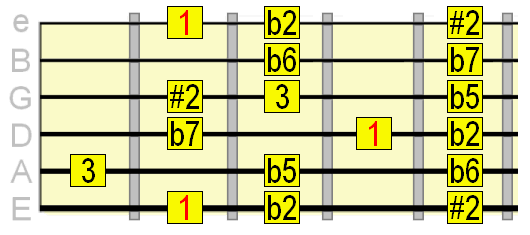
Basically, it all boils down to you making sure that you learn how your lead tones interact with chord tones. Learning scales will help, as long as you're paying attention to the intervals/tones that make up the scale and which chords they will work over.
It takes time to train your ear to hear these nuances, but trust me, it comes. The only downside (if it can be called that) is you will start analysing music in almost a scientific way, rather than enjoying it as a raw expression. But this is necessary if you're going to be able to pick up on what you hear and improvise confidently.
Guitar Chord Theory
More on Guitar Scales
More on Guitar Chords
Soloing Over Extended Chords
Up to this point we've learned how to choose the right scales for soloing over triads and 7th chords. The next step is to identify if the chord you're soloing over has any additional tones. I say if, because in most cases the chord will only extend to a 7th chord.In some cases however, especially in jazz, the chord's tones will be stacked beyond the 7th to a 9th, 11th or 13th. If this sounds completely foreign to you, I recommend first taking the extended chord theory lesson for an intro to extended chords.
Remember, effective soloing is about more than simply choosing the right scale. So although what we're learning here is a crucial first step, you still need to learn how to use scales fluidly and musically in your solos once you've chosen your scale/notes.
Identifying chord extensions in scales
The first thing to know is that both major and minor chords use the same extensions beyond the basic triad and 7th. The below table shows you which scale tones make up each type of extended chord...| Chord extension | Scale tones |
| 9th (e.g. C9, Cm9) | Triad + b7 + 2 |
| Major 9th (e.g. Cmaj9) | Triad + 7 + 2 |
| 11th (e.g. C11, Cm11) | Triad + b7 + 2 + 4 |
| 13th (e.g. C13, Cm13) | Triad + b7 + 2 + (4) + 6 |
| Major 13th (e.g. Cmaj13) | Triad + 7 + 2 + (4) + 6 |
I know what you may be thinking - how does the number 2 correspond to the number 9 in 9th chords? Well, in music theory, the 9 is technically the same as 2, 11 the same as 4 and 13 the same as 6. If you see a chord written with a 13, you should know you're looking for a scale which includes a 6th. This is why I always label my scale diagrams with their intervals.
I know it might be confusing but there is a good reason for this distinction - mainly because when the chord extends beyond the 7th, you need higher numbers to represent that.
Why have I placed the 4 in brackets for 13th and major 13th chords? Because on guitar, the 4th/11th is rarely included in these chords, for more economical fingering (after all, there are only 6 strings on the guitar and a full 13th chord with the 11th would require 7 notes to be played). The 11th is only theoretically part of the stack of tones.
Ok, before we get too bogged down in the theory, let's take a look at some practical examples.
Soloing over 9th and 13th chords
Starting with a typical dominant 9th chord (e.g. C9) form...
We can see that the tones that make up the chord are the root (1), major 3rd (3), 5th (5), minor 7th (b7) and 9th (2).
So whichever scale we choose to solo over that chord, should also include those tones (with the exception of major pentatonic which contains no 7th, but works because it is effectively "7th neutral").
Mixolydian includes all these tones...

As does Lydian dominant...

But Phrygian dominant, which we learned works naturally over dominant 7th chords, uses a minor 2nd (b2) which would clash with the major 2nd of the extended 9th chord...

The exact same scales could be used for dominant 13th chords (e.g. C13), because both Mixolydian and Lydian dominant also include the 13th (6), but Phrygian dominant uses a minor 6th (b6), so again, wouldn't be compatible.
Eventually, you won't think of it as "X scale = compatible, Y scale = incompatible", rather which tones are compatible/incompatibe. Scales are just a convenient way to group harmonically related tones together. It's the individual tones that define harmony or dissonance over a chord.
See if you can find compatible scales/tones for major 9th and major 13th chords. Use the table from earlier to help you identify the right tones.
With minor 9th chords (e.g. Cm9), it's exactly the same process, but this time we're looking for minor scales that include the root (1), minor 3rd (b3), 5th (5), flat 7th (b7) and 9th (2).
A typical minor 9th barre chord shape...

Both natural minor and Dorian would work, since they both include these tones...


But notice how natural minor wouldn't be compatible with a minor 13th chord (e.g. Cm13), because it uses a flat 6th (b6) rather than a major 6th (6).
Again, try and think more in terms of individual tones being compatible/incompatible, rather than entire scales. I've just presented it this way because it's a good starting point.
Soloing over 11th chords
You'll notice in the table earlier I didn't include a row for major 11th chords. This is because the 11th (4) tends to sound dissonant along side the intervals of the major 3rd (3) and major 7th (7).There is also (less of) a dissonance between the 11th and dominant 7th chord intervals, so what you'll find is 11th chords are simply used as extensions of suspended 4th chords, consisting of the root (1), 4th (4), 5th (5), flat 7th (b7) and 9th (2).
Here's a typical voicing for an 11th chord (e.g. C11)...

(note that the 5th is left out for more economical fingering on guitar - that's fine).
Mixolydian would work well over 11th chords...

Minor 11th chords (e.g. Cm11) include the root (1), minor 3rd (b3), 5th (5), flat 7th (b7) and 11th (4).

(Again, I've left out the 5th to make the fingering easier - as the 5th is a relatively neutral tone, the chord doesn't lose its "flavour" if you omit it).
Both Dorian and natural minor would work...


So, hopefully you're starting to get more confident with connecting the right scales/tones to extended chord types and chords in general.
Soloing over altered chords
Altered chords involve the 5th and 9th tones being sharpened or flattened, creating a distinctly jazzy sound. As jazz harmony, and therefore the scales associated with it, is a more specialised area of music theory, I won't go into it on this more general course.But do be aware of sharp or flat tones in the chords you solo over, as this will determine which scale tones should be flat or sharp. It's exactly the same process we've been following, but some chords will include tones that typical 7 note scales won't cater for.
That's why you should learn to hear and visualise how individual tones correspond to the chords you're playing over, because it'll make it easier to to sharpen or flatten a given tone if the chord harmony requires it.
For example, take this commonly used (at least in jazz!) altered chord (e.g. C7#9#5)...

The scale most players would use is the altered scale, because it accomodates those sharps (#2 and #5)...

Basically, it all boils down to you making sure that you learn how your lead tones interact with chord tones. Learning scales will help, as long as you're paying attention to the intervals/tones that make up the scale and which chords they will work over.
It takes time to train your ear to hear these nuances, but trust me, it comes. The only downside (if it can be called that) is you will start analysing music in almost a scientific way, rather than enjoying it as a raw expression. But this is necessary if you're going to be able to pick up on what you hear and improvise confidently.
| |
Tweet |
Stay updated and learn more
Sign up to the newsletter for updates and grab your free Uncommon Chords book
Sign up to the newsletter for updates and grab your free Uncommon Chords book
Related
Guitar Chord Theory
More on Guitar Scales
More on Guitar Chords








